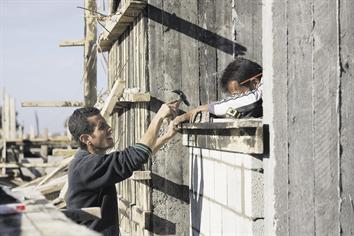In every climate-related disaster — in both richer and poorer countries — it is the poorest people who are most vulnerable and hardest hit, as climate risks are not shared equally, said a recent report by Oxfam International.
The report indicated that climate change is a costly and deadly reality that is being felt most acutely by people in lower-income countries, where millions are one drought, failed harvest, flood, or wildfire away from poverty, hunger, and death.
It added that richer people are less exposed to climate risks and better able to weather disasters, as they live in more secure places and have more assets to draw from.
On the other hand, poorer people have less protection and therefore experience greater loss and damage, which accumulates over time.
As a result, the gap between those at the bottom and those at the top grows ever wider. At the same time, richer countries have the public infrastructure and the financial might to recover more quickly; And crucially, more equal countries — whether rich or poor — are better able to mount effective collective responses in ways that do not leave poor people by the wayside.
Furthermore, UN humanitarian appeals that involve extreme weather have sharply risen over the years. In 2000, an estimated 36% of appeals involved extreme weather; by 2021 this had risen to 78%.
According to Oxfam, funding requirements for UN humanitarian appeals linked to extreme weather events have surged over the past two decades, noting that the 2019–2021 three-year average is eight times higher than the three-year average 20 years ago (2000–2002).
According to financial risk-mitigation firm Aon, 2021 was the first year the top four disasters for economic damage were weather-related. Each topped the $20bn economic loss threshold. The total economic cost of extreme weather events in 2021 is estimated at $329bn — the third-highest year on record behind 2017 and 2005
Estimates of future costs associated with loss and damage range from $290bn to $580bn.
These figures are high, but the costs are dwarfed by the billions in subsidies the fossil fuel industry receives and the profits it makes. In 2021, 25 oil and gas companies made $205bn in profits. The UNDP estimates global fossil fuel subsidies are $423bn per year.
Structurally and economically devastating events are happening all over the world, but climate-vulnerable low-income countries lack the safety nets and resources to cope, compared to richer countries.
The difference was exemplified by former German chancellor Angela Merkel announcing a reconstruction fund of €30bn just weeks after the 2021 summer floods. By contrast, Vanuatu’s public debt has doubled in recent years, largely due to rebuilding after 2015’s Cyclone Pam.
Polluters have a duty to pay
Rich countries have contributed an estimated 92% of excess historical emissions and are responsible for 37% of current emissions despite being home to only 15% of the global population. In stark contrast, Kenya, Ethiopia, Somalia, and South Sudan are together responsible for a mere 0.1% of global emissions.
Rich countries have fiercely resisted progress at every turn; global cooperation on climate change includes agreements that developed countries will provide finance to enable developing countries to reduce their emissions (e.g. by connecting homes to renewable energy), and adapt to a changing climate (e.g. by making homes flood-resistant). But if homes are destroyed by a climate-related disaster, rich countries have no financial commitments or obligations to help pay for such damage.
At the 26th Conference of Parties on Climate Change (COP 26) last year, developing countries’ proposal for a finance facility to address loss and damage was rejected in favour of a three-year Glasgow Dialogue to discuss funding arrangements.
If the Dialogue is to be more than a talking shop, it needs to facilitate meaningful COP outcomes, including an agreement to establish a new facility and advance new innovative sources of finance alongside rich country contributions.
The costs of climate impacts will continue to skyrocket with every fraction of a degree of warming. Emissions are rising and temperature increases are on track for 2.4° C, if not more.
Even with ambitious plans to cut emissions and adapt, further consequences of climate change are no longer avoidable, and failure to slash emissions means that far worse may be on the horizon.
Existing arrangements to address loss and damage mainly comprise humanitarian and development aid and insurance. Based on the principles of charity and enlightened self-interest (and sometimes overt geopolitics), the foundations and functioning of the current aid systems are unaligned with the principles of climate justice.
Accordingly, the Oxfam report has proposed several recommendations to governments ahead of the COP 27.
The first of which is to establish a finance facility to address loss and damage under the UNFCCC to coordinate an effective and equitable global response to climate-induced loss and damage.
The report also indicated that governments need to agree to establish a system of financial support for action to address loss and damage that involves annual country contributions based on the UNFCCC principle of common but differentiated responsibilities and respective capabilities.
Furthermore, the COP 27 should focus the Glasgow Dialogue on establishing a finance facility and defining its governance and delivery structure, the report indicated, adding that it should identify funding needs and resource mobilisation, including from innovative sources.
Oxfam also recommends that national loss and damage finance needs become a core element of the UNFCCC Global Stocktake.
Moreover, the loss and damage should be included in the new quantified climate finance goal post-2025 under the Paris Agreement.
“Loss and damage becoming a standing agenda item for future COPs, so there is a guaranteed negotiating space to advance action each year,” the recommendations read.
Finally, Oxfam recommends that gender should be mainstreamed by making loss and damage a core element in the UNFCCC’s Gender Action Plan, including ensuring all action has an explicit gender lens so it does not exacerbate existing inequalities.




